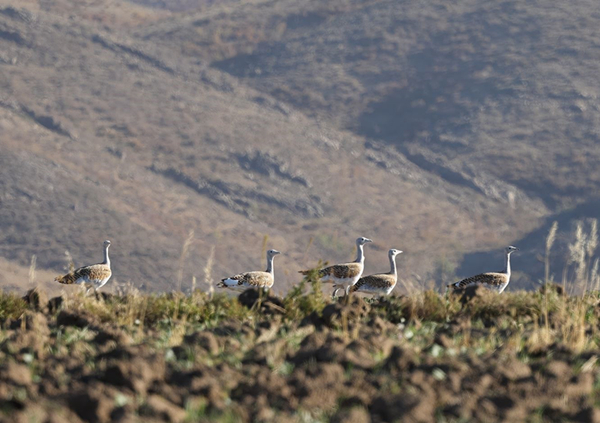Study: Anthropogenic Disturbance Was the Main Factor Affecting Habitat Quality of Great Bustard in Western China
2021-12-06
A joint study led by Xinjiang Institute of Ecology and Geography of the Chinese Academy of Sciences and Eurasian Bustard Alliance has found that anthropogenic disturbance become one of the main factors lead to decrease of habitat quality of China's Otis tarda tarda population.
The results were published in Global Ecology and Conservation, entitled "Habitat suitability assessment for the Great Bustard Otis tarda tarda in Tacheng Basin, western China".
Habitat loss and fragmentation caused by anthropogenic disturbance has become one of the main factors contributing to the decline of wildlife population and even the extinction of species. With the development of society and economy, the increasing number of roads and infrastructure, and the change of land use type have intensified the fragmentation of wildlife habitat, significantly changed its distribution and increased the risk of species extinction.
The Great Bustard (Otis tarda) is classified in the highest protection category in China. And it is currently listed as Vulnerable (VU) by the International Union for Conservation of Nature (IUCN). The Western Great Bustard, O. t. tarda, is distributed only in the Xinjiang of northwestern China. Nearly 70% of this Chinese population of the Western Great Bustard is found in the Tacheng Basin. But the number of the population counted has declined by over 90% over the last thirty years. However, the reasons for the population decline of Great Bustard in this area are not clear, and decrease of suitable habitat may be evolved as one of the potential factors.
In this study, researchers evaluated the habitat quality of Great Bustard in Tacheng Basin by using an ensemble species distribution model, revealed the key factors leading to the rapid population decline, and proposed specific conservation measures.
The results showed that the suitable habitat area of Great Bustard in Tacheng Basin was very small, only accounting for 9.9% of the total area of the study area, and mainly distributed in the northern edge of the basin and the southern slope of Talbahetai Mountain. The main factors affecting habitat quality of Great Bustard were distance to county road (anthropogenic disturbance), distance to farmland (food resources) and average summer temperature (reproduction and survival temperature).
Researchers recommend conservation advocacy among the local population; Regulating bird photography and bird-watching tourism activities; Measures taken to reduce the interference of roads to Great Bustard during breeding period. And establish the Great Bustard protection demonstration area. With climate change, land use change and agricultural planting structure change, we must pay attention to the survival status of this endangered species, further predict the habitat quality of great bustard in the Tacheng Basin in the future, and put forward the priority conservation plan for the important habitat of Great Bustard.
Article link: https://doi.org/10.1016/j.gecco.2021.e01926

Great Bustard (Otis tarda tarda)



